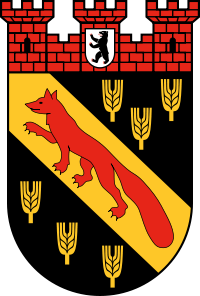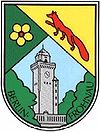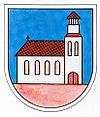Coat of arms of the Reinickendorf district
The coat of arms of the Reinickendorf district was newly created for the Reinickendorf district of Berlin and awarded by the Berlin Senate on November 28, 1955 .
Blazon
“In a black shield a golden sloping bar, covered with a running red fox and accompanied by six (3: 3) golden ears. A red three-tower wall crown rests on the shield, the middle tower of which is covered with a small Berlin coat of arms. "
History and meaning
Reinickendorf
The coat of arms of the rural community Reinickendorf was designed after the seal of the community. The coat of arms shows in a silver shield on green ground a natural oak on the right, a golden grain field on the left and a sitting red fox in front of both. The oak has green foliage and a golden trunk. A scythe and a rake lean against the branches from the right. The woodwork is golden and the iron is blue. Even if the name Reinickendorf goes back to its founder, the Lower Saxon farmer Reinhardt, the coat of arms with the motif of the " Reinecke Fuchs " is understood as a talking coat of arms . The scythe, the rake and the grain field indicate the main occupation of the population, agriculture. The oak stands for the abundance of forests. Due to the increasing industrialization in the 19th century, the incorporation into Berlin and the ever increasing urban expansion, nothing left of the agriculture and the forests.
District coat of arms
The group formed in 1920 and in Greater Berlin eingemeindeten Reinickendorf district had at first only a crest-shaped emblem. The emblem had been developed from the seal image of the former rural community Reinickendorf, which had been transformed into a coat of arms, and was used informally.
On November 28, 1955, the district was given its own coat of arms. Since it was not possible to adopt the emblem as a coat of arms due to the naturalistic design that is not usual in heraldry, a new coat of arms was designed by Rudolf Pfefferkorn on behalf of the Berlin Senate. The coat of arms shows a golden diagonal bar in a black shield, which is covered with a red running fox. There are three golden ears of wheat to the left and right of the bar. The top of the wall connecting all districts with Berlin rests on the sign . The motif of the "Reinecke Fuchs" as a talking coat of arms was taken from the Reinickendorf coat of arms. On the one hand, the golden ears of corn symbolize the agricultural character of the former independent communities in the district. On the other hand, the number of them symbolize the six incorporated communities: Heiligensee , Hermsdorf , Lübars , Reinickendorf , Tegel , Wittenau . The tinging of the coat of arms in the colors black-red-gold was deliberately chosen and is otherwise not represented in any of the other Berlin district coats of arms . Since only the color red came into question for the fox, the tinging of the other elements was self-evident according to the heraldic rules.
After the district mergers on January 1, 2001 in Berlin, the coat of arms of Reinickendorf, like the coat of arms of all other districts, was given a new crown.
Coats of arms of the districts
Reinickendorf wasn't the only one with its own coat of arms. The other districts also had their own coats of arms before they were incorporated into Greater Berlin . The coats of arms of the districts lost their validity with the incorporation into Greater Berlin and disappeared from official use.
Frohnau
As an independent municipality, Frohnau never had a coat of arms. As a district of Berlin, Frohnau initially did not use a coat of arms. After all parts of the Reinickendorf district had a coat of arms, the Frohnau e. V. 1987 a competition for the most beautiful design of a coat of arms. A large number of citizens took part in this competition, so the decision was not an easy one. After much deliberation, the design by Ms. Barbara Walkowiak was chosen. With the help of Mr. Peter Bauer, this design was implemented in the design used today, which, however, does not entirely correspond to the heraldic rules. The original is in the Reinickendorf town hall.
The coat of arms shows a yellow (golden) blossom in a green field at the top right. It symbolizes the garden city of Frohnau. In the lower blue field, the casino tower can be seen in silver, the 30 m high landmark of the district, built in 1909-10. The tower is flanked by green trees and bushes that merge into one another. They symbolize the abundance of forests in the district. In the green areas at the bottom right “BERLIN-” and left “FROHNAU” stands for the name of the district. In the upper left field there is a red fox in a yellow (gold) field. It symbolizes belonging to the Reinickendorf district.
Heiligensee
The municipality of Heiligensee has had a seal with the legend "GEMEINDE VORSTEHER HEILIGENSEE - KREIS NIEDERBARNIM" since the 19th century. In the picture it showed symbols of agriculture and fishing. The coat of arms, designed after the seal, shows a golden sheaf in a silver shield on a green ground. The sheaf is stuck diagonally to the right with a scythe and rake. The woodwork is golden and the iron is blue. On the left of the shield there is a green linden tree with a golden trunk. The lower part of the trunk is covered by the handle of a fish net placed diagonally to the right, while the bag of the fish net hovers over the sheaf. The handle is golden and the iron is blue. The agricultural motifs symbolize the main livelihood of the then population of the village community. The fishing net symbolizes the second line of business, fishing, of the village located on a peninsula between Nieder Neuendorfer See ( Havel ) and Heiligensee . The linden tree represents the abundance of forests at that time.
Hermsdorf
The seal of the municipality of Hermsdorf also contained the inscription "GEMEINDE VORSTEHER HERMSDORF - KREIS NIEDERBARNIM". The village church was used as the image, which was also incorporated into the coat of arms. The coat of arms shows a silver church with a tower on the left in a blue shield on a red floor. The church tower is windowed, has a golden gate and a red pointed roof with a golden flag waving to the left on the top. The church building is also windowed and has a red gable roof, which has dormer windows and the ridge on the right with a cross.
Lübars
The seal and coat of arms of the community Lübars shows symbols of agriculture. In Blue Shield there are three golden sheaves next to each other on green ground. The middle sheaf is equipped with an upright rake, a scythe slanting to the left and a flail slanting to the right. The three devices are silver tinged. This coat of arms also indicates an agricultural activity of the community residents at that time.
Tegel
The coat of arms of the municipality of Tegel is a bit unusual for a municipality in the interior of the country. It shows in a blue sign on green waves a golden steamship moving from right to left with a red flag and red flags. Silver smoke rises from the black chimney of the ship. The waves symbolize the Tegeler See , on the banks of which Tegel lies. Tegel's importance as a port for passenger shipping is expressed through the ship.
Wittenau
The seal and the later coat of arms of the municipality of Wittenau were only created after the municipality was renamed on August 28, 1905. Before that, the municipality was called Dalldorf. The inscription on the seal reads: "GEMEINDE WITTENAU KREIS NIEDERBARNIM". Wittenau's coat of arms shows a green fir tree with a green trunk in a silver shield on a green ground. A scythe and a wooden pitchfork are leaning on the right. The woodwork is golden and the iron is blue. On the left is a golden sheaf, which is held together with a red ribbon. Again, as with the other coats of arms, the agricultural symbols refer to the main occupation of the population. The fir stands for the former forest wealth of the community.
Märkisches Viertel
The coat of arms of the Märkisches Viertel was found through an open competition that was sponsored by two new investors after the large housing estate was dedicated in 1999 as the district's own official district. The four-member jury, appointed by the Reinickendorf district, decided in February 2000 in favor of the design by Marko Postranecky, then 18 years old. In the picture, people are picnicking in a meadow surrounded by a lake, trees and high-rise buildings. The coat of arms shows six silver-gray divided concrete blocks in blue, in two rows one behind the other, each staggered diagonally and vertically, each of which has a brown fir tree on its base. The fir trees are rooted in the green base of the shield, covered with a broad linden tree, under one side of which two seated people are picnicking, underneath a sickle-shaped blue shield edge. The district has had the coat of arms since 2002.
Konradshöhe
Heraldist Harry Pohle created a coat of arms for the district of Konradshöhe / Tegelort in 2001 , which the district has had since 2002. It shows three blue fir trees on a silver shield above four blue wavy ribbons, the bottom ribbed ribbon in the base of the shield half cut.
Huntsmanship
Waidmannslust carries a coat of arms, in a green shield the hunting trophy of a deer with golden antlers and golden skull, a silver ring of teeth floating between the antler bones.
literature
- Heinz Machatscheck: When the heraldic bear was born. Berlin-Information, Berlin 1987, ISBN 3-7442-0005-1 .
- Werner Vogel : Berlin and its coat of arms. Ullstein, Berlin 1987, ISBN 3-550-07818-8 .
Web links
- Reinickendorf coat of arms on berlin.de
Individual evidence
- ↑ Source: National emblem of Berlin - district coat of arms
- ^ Leif Allendorf: Picnic on a meadow in front of high-rise buildings . In: Berliner Zeitung , February 2, 2000, Local; for the presentation of the winning design.
- ↑ The district of Märkisches Viertel . berlin.de; accessed on March 20, 2016.
- ↑ The district Konradshöhe Tegelort . ( Memento from December 1, 2008 in the Internet Archive ) reinickendorf.de, Reinickendorf District Office of Berlin
- ↑ The Konradshöhe district . berlin.de; accessed on March 20, 2016.
- ↑ The Waidmannslust district . berlin.de, accessed on March 20, 2016.




